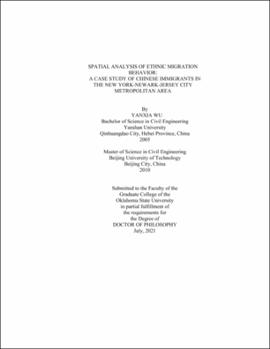| dc.contributor.advisor | Comer, Jonathan C. | |
| dc.contributor.author | Wu, Yanxia | |
| dc.date.accessioned | 2022-01-21T19:20:04Z | |
| dc.date.available | 2022-01-21T19:20:04Z | |
| dc.date.issued | 2021-07 | |
| dc.identifier.uri | https://hdl.handle.net/11244/333783 | |
| dc.description.abstract | The population of Chinese immigrants in the United States has undergone progressive growth in the past 50 years and has reached an epidemic number. As minorities, the Chinese immigrants move into receiving places to adapt and succeed in a new social structure while not losing their own identity. Previous studies highlight the role of local contexts that lead to an internal moving decision. Most of these studies view local contexts as global factors assumed to apply equally over a study area. However, the contextual factors do not disperse evenly across space, nor their relationships with migration behavior. Understanding the spatial variability of factors related to Chinese people's migration in the study area is necessary. Therefore, this dissertation aims to explore the role in which neighborhood context may predict migration behavior, with particular attention to how migration factors and their effects vary across space. This research presents novel applications of two methods: clustering analysis (followed by regression models) and multiscale geographically weighted regression (MGWR) to the Chinese population in the New York-Newark-Jersey City metropolitan statistical area as a case study. Besides regression analysis, this research also provides a detailed examination of relationships between micro-level factors using decision tree analysis. Wages, education, English proficiency, and self-employment status are crucial variables in differentiating movers from non-movers. Having naturalized citizenship has a dual effect on migration behavior. Among the movers, stratifications exist in the immigrant Chinese population. Each subgroup has its particular migration pattern and significant indicators. Spatial variations exist in the study area. Neighborhood type 2 (low in socioeconomic and stable status) is the residential place for immigrants from other states. And neighborhood type 1 (high in socioeconomic and stable status) has more within-state immigrants. Regression models accounting for the population stratification and spatial variations have a vast improvement over the OLS model. Approaches considering data associations in both geographic dimension and non-geographic dimensions could be promising. | |
| dc.format | application/pdf | |
| dc.language | en_US | |
| dc.rights | Copyright is held by the author who has granted the Oklahoma State University Library the non-exclusive right to share this material in its institutional repository. Contact Digital Library Services at lib-dls@okstate.edu or 405-744-9161 for the permission policy on the use, reproduction or distribution of this material. | |
| dc.title | Spatial analysis of ethnic migration behavior: A case study of Chinese immigrants in the New York-Newark-Jersey City metropolitan area | |
| dc.contributor.committeeMember | Yu, Hongbo | |
| dc.contributor.committeeMember | Wikle, Thomas A. | |
| dc.contributor.committeeMember | Fullerton, Andrew S. | |
| osu.filename | Wu_okstate_0664D_17323.pdf | |
| osu.accesstype | Open Access | |
| dc.type.genre | Dissertation | |
| dc.type.material | Text | |
| dc.subject.keywords | chinese immigrants | |
| dc.subject.keywords | migration behavior | |
| dc.subject.keywords | spatial analysis | |
| thesis.degree.discipline | Geography | |
| thesis.degree.grantor | Oklahoma State University | |
